Top Image: USS California after the attack on December 7. Official US Navy photograph 80-G-32740, courtesy of Naval History and Heritage Command.
When torpedoes and bombs began to fall from Japanese aircraft onto the American battle fleet at anchor in Pearl Harbor in the early morning of December 7, 1941, sailors rushed into action. When their acts were tallied after the attack, 15 men of the US Navy were awarded the Medal of Honor for their heroics that fateful morning. Four of those went to sailors and one officer aboard the stricken USS California (BB-44). Of the four, only one survived.
Often forgotten alongside the tragedies which befell the USS Arizona (BB-39) and USS Oklahoma, (BB-37) California suffered significantly in the attack on December 7. Moored alone on Battleship Row, California lay in just 40 feet of water. Within minutes of the start of the attack, two torpedoes punched through the hull in separate locations beneath the armored belt on the port side of California, ripping the ship wide open. Seawater quickly mixed with the fuel oil, resulting in equipment failures and all power and lights were lost. Several minutes later, a bomb exploded off the port bow—a near miss which still caused damage. California was quickly taking on water and beginning to go down by the bow as a list to port became noticeable. Damage control teams began counterflooding starboard compartments to minimize the list. At approximately 8:45 a.m., a bomb hit the upper deck, penetrated to the second deck, exploded, and started a fire. Power was restored to the ship as crews worked to build up the steam needed to get underway. Fuel oil from ruptured tanks began flooding compartments and the fumes overtaking men passing badly needed ammunition to gunners above by hand. The situation was grim.
-

Listing to port and still taking on water, USS California burns from a Japanese bomb that exploded on her second deck. To the left is USS Nevada (BB-36) after her crew beached her to avoid sinking in the channel. US Navy photograph 80-G32456, courtesy of Naval History and Heritage Command.
-

Crew abandon California as burning fuel oil begins to surround the ship. The fires were eventually contained, saving California from further destruction. Official US Navy photograph NH 97400, courtesy of Naval History and Heritage Command.
When the attack began on December 7, many sailors and officers were not aboard their respective ships. Saturday nights were popular liberty nights, and many ships found themselves under the leadership of junior officers. As the situation worsened aboard California, neither her commanding officer, Captain J.W. Gunkley, nor the executive officer, Commander E.E. Stone, were aboard. For the first hour, the fate of the ship fell to junior officers like Ensign Herbert C. Jones.
Ensign Herbert Jones
Herbert C. Jones, of Coronado, California, enlisted in the US Naval Reserve in 1935 at the age of 17. After completing two years of college, Jones received Midshipman’s training aboard the drill ship Prairie State (XI-15) and was commissioned an Ensign in November 1940. Jones arrived in Hawaii in early 1941, and was joined shortly after by his fiancé, Joanne. They married in June, and Joanne lived in Honolulu. On December 7, as California lost power, gun crews were doing their best to respond and fire on incoming Japanese aircraft. The ship had been in peacetime conditions with little ammunition available topside, meaning any additional ammunition had to be brought up from magazines below. With the power out, 5-inch ammunition had to be brought up by hand. Each shell weighed more than 50 pounds.
As California had come under fire, Jones had already rescued a sailor from a smoke-filled compartment and led an anti-aircraft battery in firing on the incoming Japanese planes. When the gun crews began to run out of ammunition, Jones organized and led a group of sailors to bring ammunition up from magazines several decks below. The group worked tirelessly to keep the guns supplied, passing ammunition by hand until the bomb blast rocked California around 8:45 a.m. Jones was fatally wounded in the blast. Two sailors attempted to evacuate him from the compartment, which was beginning to go up in flames, but Jones refused, worried more for their lives than his own. His final words were quoted as, “Leave me alone! I am done for. Get out of here before the magazines go off.” Ensign Herbert Charpiot Jones was 23 years old.
Ensign Herbert Charpiot Jones Medal of Honor Citation
“For conspicuous devotion to duty, extraordinary courage, and complete disregard of his own life, above and beyond the call of duty, during the attack on the Fleet in Pearl Harbor, by Japanese forces on 7 December 1941. Ens. Jones organized and led a party which was supplying ammunition to the antiaircraft battery of the USS California after the mechanical hoists were put out of action, when he was fatally wounded by a bomb explosion. When two men attempted to take him from the area which was on fire, he refused to let them do so, saying in words to the effect, ‘Leave me alone! I am done for. Get out of here before the magazines go off.’"
Gunner Jackson Pharris
Leadership amidst the chaos of that morning was found at all ranks. Gunner Jackson Charles Pharris had been promoted to Warrant Officer in January 1941, aboard USS Mississippi (BB-41). Transferred to California shortly after, Pharris was in charge of an ordnance repair party on the third deck on the morning of December 7. A Georgia native, Pharris joined the US Navy in 1933 at 20 years old and reported aboard Mississippi shortly after.
Lieutenant Jackson C. Pharris, taken after the Pearl Harbor attack and his commissioning. Image courtesy of Naval History and Heritage Command.
When the first torpedo hit California, it burst through the ship’s hull just below Pharris’s station on the third deck. Stunned and severely wounded from the blast concussion, Pharris was thrown upwards into the overhead (ceiling) and back down to the deck. Gathering himself quickly, Pharris organized his men to begin an ammunition train for the ship’s anti-aircraft guns. While men worked to pass ammunition by hand up three decks of the ship, water and fuel oil began to rush into the compartments. The ship’s electricity failed, but the men carried on in the dark. When the ship began to list to port, Pharris ordered shipfitters to begin counterflooding. The noxious fumes from the fuel oil twice rendered Pharris unconscious, but each time he came to, continuing his efforts to speed up the flow of ammunition topside. As compartments filled with dangerous fumes, fuel oil, and water, Pharris rescued unconscious sailors. He is credited with saving the lives of 17 shipmates, pulling them from compartments where many had become submerged in oil. He was considered chiefly responsible for keeping California’s gun crews in the fight.
Despite his serious wounds, Pharris survived. He spent some time in hospitals recovering from the fuel oil which had gotten into his lungs. Pharris returned to California, and in July 1942, was commissioned an officer. He returned to a US Naval hospital for treatment in 1943 for damage to his lungs for the fuel oil still present there. Pharris returned to duty, ending the war as an officer aboard USS Saint Paul (CA-73). Initially, Pharris was awarded the Navy Cross for his actions on December 7. In 1948, a review of the action resulted in Pharris’s award being upgraded to the Medal of Honor. Then Lieutenant Pharris received the medal from President Harry S. Truman at a ceremony at the White House on June 25, 1948, alongside Iwo Jima recipient Francis Pierce.
Lieutenant (then Gunner) Jackson Charles Pharris Medal of Honor Citation
“For conspicuous gallantry and intrepidity at the risk of his life above and beyond the call of duty while attached to the USS California during the surprise enemy Japanese aerial attack on Pearl Harbor, Territory of Hawaii, 7 December 1941. In charge of the ordnance repair party on the third deck when the first Japanese torpedo struck almost directly under his station, Lt. (then Gunner) Pharris was stunned and severely injured by the concussion which hurled him to the overhead and back to the deck. Quickly recovering, he acted on his own initiative to set up a hand-supply ammunition train for the antiaircraft guns. With water and oil rushing in where the port bulkhead had been torn up from the deck, with many of the remaining crewmembers overcome by oil fumes, and the ship without power and listing heavily to port as a result of a second torpedo hit, Lt. Pharris ordered the shipfitters to counterflood. Twice rendered unconscious by the nauseous fumes and handicapped by his painful injuries, he persisted in his desperate efforts to speed up the supply of ammunition and at the same time repeatedly risked his life to enter the flooding compartments and drag to safety unconscious shipmates who were gradually being submerged in oil. By his inspiring leadership, his valiant efforts, and extreme loyalty to his ship and her crew, he saved many of his shipmates from death and was largely responsible for keeping the California in action during the attack. His heroic conduct throughout this first eventful engagement of World War II reflects the highest credit upon Lt. Pharris and enhances the finest traditions of the U.S. Naval Service.”
Chief Radioman Thomas Reeves
Chief Radioman Thomas Reeves was an “old salt” by December 1941. Born in Connecticut in 1895, Reeves first joined the Naval Reserve during World War I. Discharged after the war, Reeves enlisted in the regular navy in 1921. Rising through the enlisted ranks, Reeves had become a Chief Petty Officer, having spent time aboard various battleships in the fleet. As the situation worsened aboard California during the attack, Reeves was forced to abandon the main radio room. Reeves, at the request of Gunner Pharris, helped hand pass ammunition from below decks to the anti-aircraft crews above. Despite the danger and disregarding his own safety, Reeves stayed in a burning passageway, passing ammunition until the smoke and flames overtook him. Chief Radioman Thomas James Reeves was two days away from his 46th birthday.
Chief Radio Electrician Thomas James Reeves Medal of Honor Citation
“For distinguished conduct in the line of his profession, extraordinary courage, and disregard of his own safety during the attack on the Fleet in Pearl Harbor, by Japanese forces on 7 December 1941. After the mechanized ammunition hoists were put out of action on the USS California, Reeves, on his own initiative, in a burning passageway, assisted in the maintenance of an ammunition supply by hand to the antiaircraft guns until he was overcome by smoke and fire, which resulted in his death.”
Machinist’s Mate First Class Robert Scott
Born in Ohio in 1915, Robert Scott joined the US Navy in early 1938, and reported aboard California in August of that year. When the call to general quarters sounded, Scott reported to his battle station—working an air compressor in a forward compartment below decks. The compressor was a vital part of several systems onboard the ship, as evidenced by the fact it was a battle station for a highly rated enlisted man. After the torpedo hits caused extensive flooding, the sailors in the compartment began to evacuate. Scott refused to leave even as the water and oil crept waist high. Gunner’s Mate V.O. Jensen recalled urging Scott to leave the compartment. Blacking out himself, Jensen prepared to abandon the compartment, leaving Scott behind. Scott’s last words to Jensen were, “As long as I can give these people air, I’m sticking.” Machinist’s Mate First Class Robert Raymond Scott was 26 years old.
Machinist’s Mate First Class Robert Raymond Scott Medal of Honor Citation
“For conspicuous devotion to duty, extraordinary courage, and complete disregard for his own life, above and beyond the call of duty, during the attack on the Fleet in Pearl Harbor by Japanese forces on 7 December 1941. The compartment in the USS California in which the air compressor to which Scott was assigned as his battle station was flooded as the result of a torpedo hit. The remainder of the personnel evacuated that compartment, but Scott refused to leave, saying words to the effect: ‘This is my station and I will stay and give them air as long as the guns are going.’"
It took nearly three days for California to settle in the soft mud at her berth at Ford Island. The ship had briefly been abandoned on December 7 as an oil fire on the water surrounded the ship. The fire was controlled, and crews returned, but without sufficient power to run pumps she slowly settled in 40 feet of water, sinking into the soft mud. California was refloated the following March, cleaned, repaired, and returned to service, earning seven battle stars during the war. One hundred and three of her crew, including four Marines in the ship’s detachment, died in the attack. Three of them would be posthumously awarded the Medal of Honor.
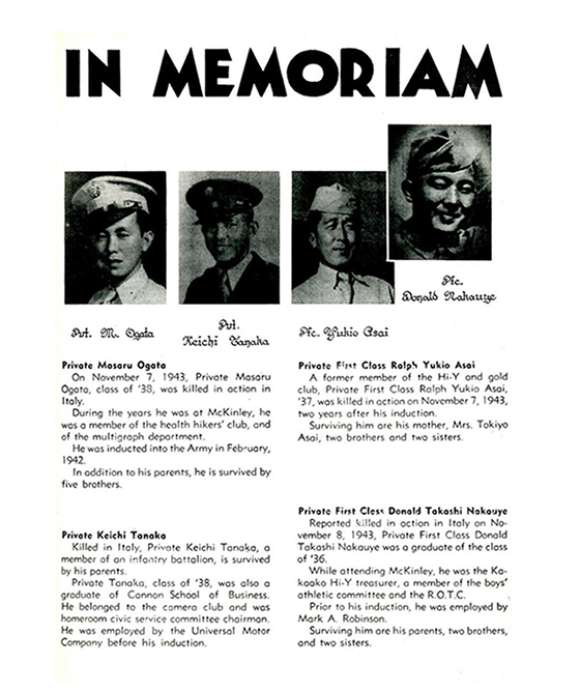
Pearl Harbor Education Resources
Free resources for your classroom to commemorate the December 7,1941 attack.
Kali Martin
Kali Martin is a former Research Historian of The National WWII Museum's Jenny Craig Institute for the Study of War and Democracy.
Cite this article:
MLA Citation:
APA Citation:
Chicago Style Citation:
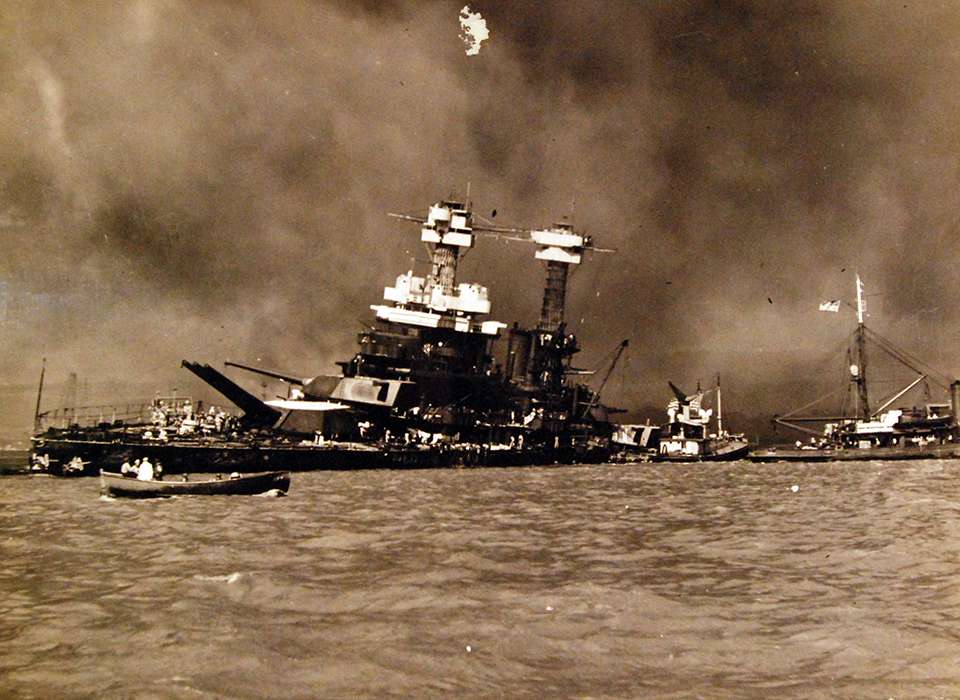
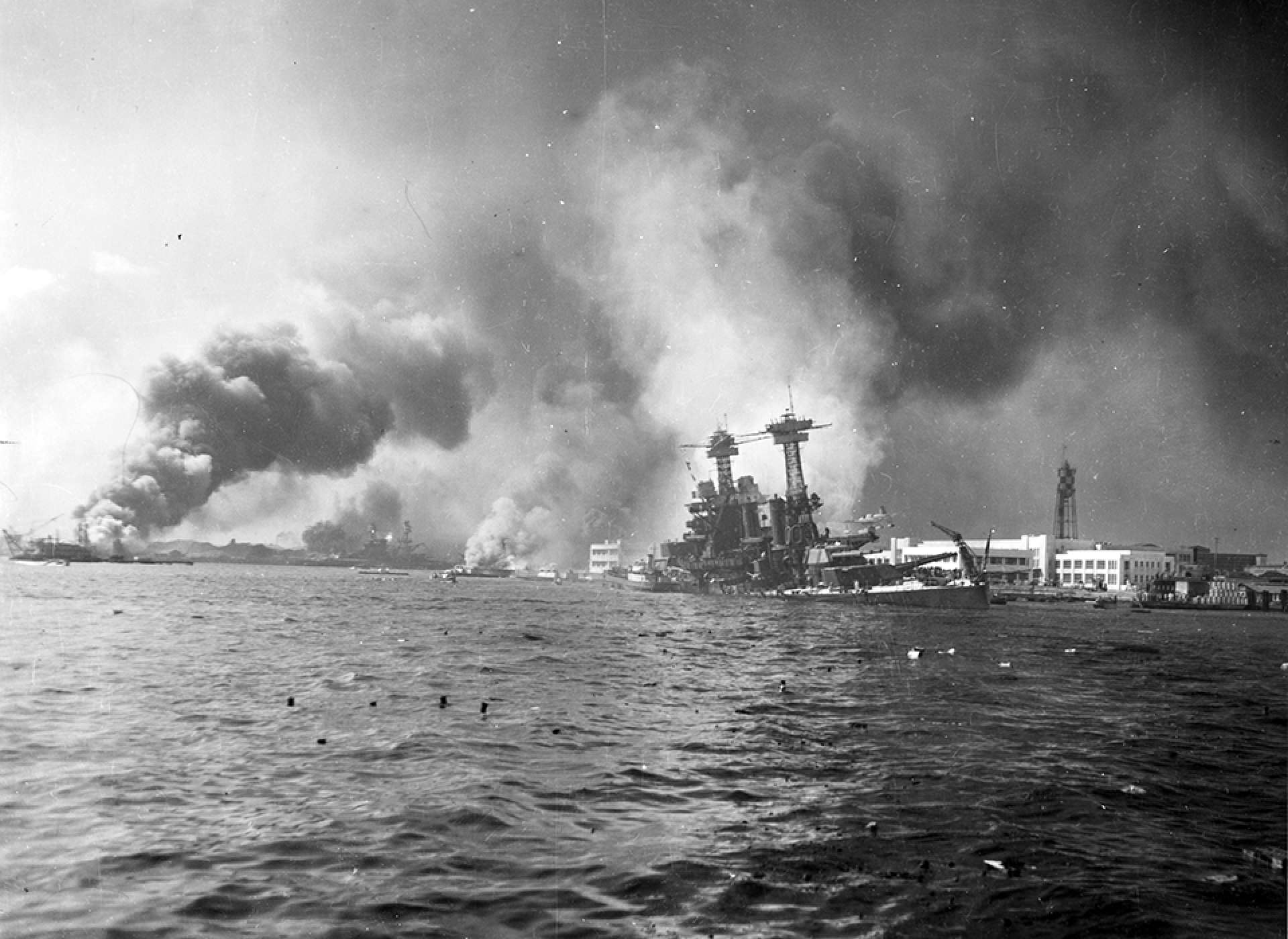
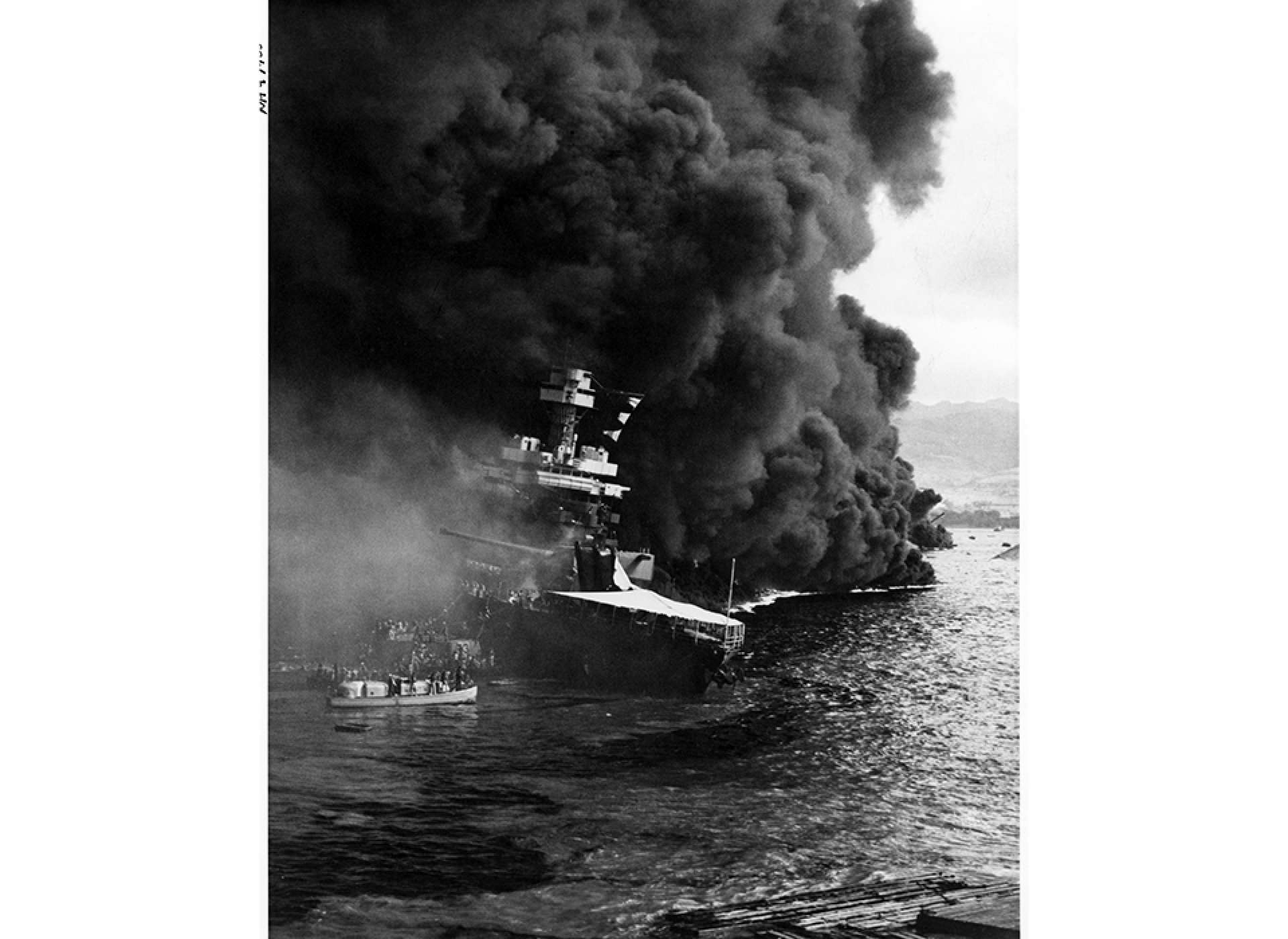



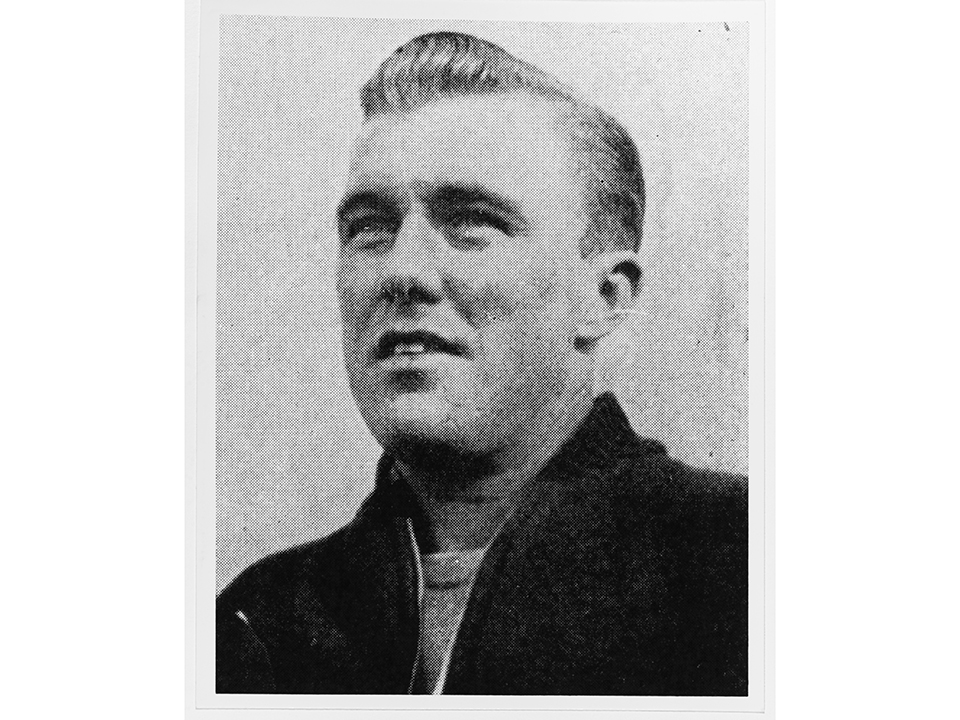






![Max Fuchs, New York City cantor, sings as Rabbi Sydney [sic] Lefkowitz, Richmond, VA, conducts the first Jewish services from Germany.](/sites/default/files/styles/max_650x650/public/2025-10/image1.jpg)

